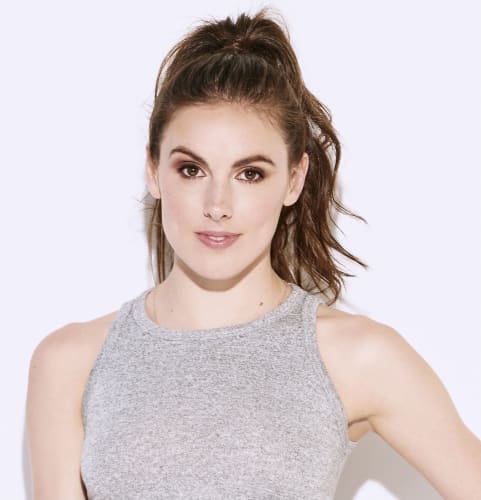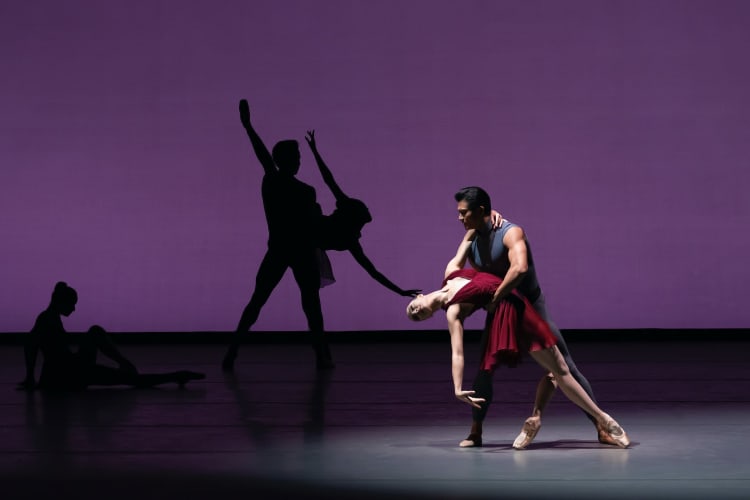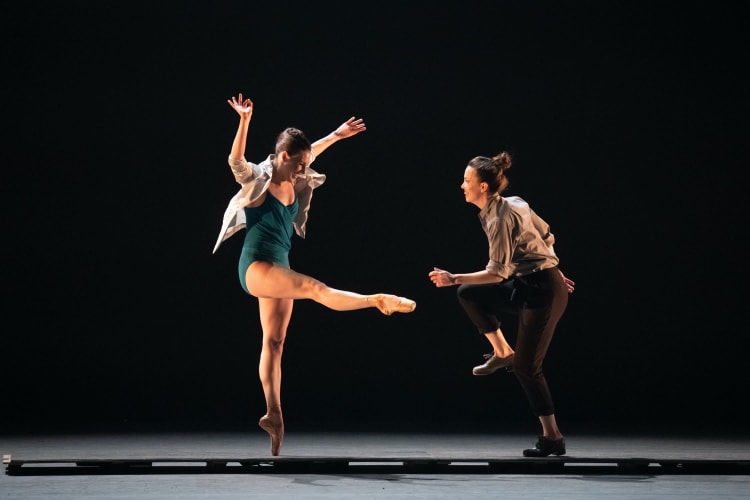Tiler Peck is no stranger to the limelight. As principal dancer of the New York City Ballet, she has hit the ground running following the global première of Concerto for Two Pianos, her first piece choreographed for the NYCB, and is nominated for an Olivier Award for Time Spell, in collaboration with Michelle Dorrance and Jillian Meyers, after wowing London audiences with her directorial debut at Sadler’s Wells last March, Turn It Out with Tiler Peck & Friends.
I caught up with Peck on Zoom from her NYCB headquarters and, even though we are connecting virtually, her effusive, infectiously sunny nature only funnels positive energy through the Internet highway and into my front room.
At 35, Peck is clearly on top of her game, both balletically and creatively. She is passionate about her artform and wants to impact change from within the institutions that dictate what ballet will look like one day. She is also aware that, as a women and ballet dancer, she is a rare breed in terms of making new work.
I ask Peck why she thinks this is the case, given contemporary female choreographers are commissioned by ballet companies, but rarely female ballet choreographers. This hits a raw nerve, albeit handled with her southern Californian easiness.
“You have these choreographers like Pam Tanowitz and Crystal Pite who are incredible, but these dance makers are from different genres, mostly bringing contemporary into a classical setting. But where are the female ballet dancers making ballets?” she asks, mentioning Gemma Bond, who recently created Boundless for the Festival of New Choreography, Royal Opera House, as a rare inspiration.
Peck says she feels lucky to dance in a ballet company with the best choreographers in the repertoire, male, female, alive or dead. “You learn so much by dancing George Balanchine, Jerome Robbins and living in the structure of that,” but she missed not having a direct role model to lean into as she moved swiftly up the ranks.
“None of the choreographers I have grown up with are female. There hasn’t been a strong female I’ve been able to work with and look up to in the company, so I like to think that’s what I can be for the dancers at NYCB,” and she uses this as motivation to create work.
Peck thinks the dearth of female ballet choreographers is perhaps due to the unequal division of labour between male and female dancers more than institutionalised discrimination in ballet companies.
“When you are a principle, it takes all your mind space, so there is literally nothing left. What put me off in the past is that I could never find enough time to do it at 110 percent.”
She explains that it’s just much easier for male dancers to be choreographing and moving back to ballet repertoire and performance, partnering a ballerina. Simply, the workload has different demands.
And if you consider Peck’s average day, it’s Olympian in terms of the daily grind. “At 10:30AM, there’s ballet class, where training skills are honed, followed by six-hours of rehearsals,” and if Peck is working on a show, another three hours squeezed somewhere to work on her choreography. Then there’s the performance, finishing around 10:30PM. No wonder she’s partial to pizza and pasta to keep energy levels up.
This just makes Peck’s achievements all the more remarkable. And not only does she throw herself into making new work, but her method of creativity is radical in itself. She shows, not tells, her dancers how the steps work, and she does all of this wearing her beloved pointe shoes. “I’m never just front of the room,”—shop talk for rehearsal studio—“but up there with them doing it.”
In 19 years of being a company member, she explains, not once has a choreographer done this for her, as they mostly, she says, wear soft shoes or socks. Instead, Peck gets on pointe and places her dancers into her choreography. This gives her access and insight into the way dancers grapple with her new material. Her method, she says, is friendly, but rigorous. “The fact that I could be in pointe shoes and have a feminine take on the material is a real advantage,” she says. “I know what the shoes can do, and every piece I create is on pointe because there are so few of us who actually love pointe shoes, and I’m very precise about the steps.”
Visualisations are used to describe exacting positioning of the body for her new choreography. “Place your foot down so softly that it wouldn’t crack an egg. I speak with the feet and these types of images,” she laughs.
As a dance maker, another advantage she has is that she intimately understands her dancers and in turn they hold deep faith in Peck. “What I was hoping for was to inspire my dancers and to give them tools that they could use in all of their ballets throughout their career, not just my ballet,” she hopes.
So how did Peck break the mould where so few fear to tread? Peck attributes this entirely to her background growing up in her mum’s dance school, which prepared her for anything. “I always choreographed for my mum, but I never thought it was something I would want to do professionally,” she says.
Peck explains that she started dancing from three years old, and ballet was harder, less fun than other forms of dance. She loved taking jazz, tap and hip-hop classes at her mum’s studio. “I didn’t grow up listening to classical music on the radio, so it took me longer to appreciate the craft. I'm so grateful to my mum, who said it doesn’t matter what kind of dancer you become, you need ballet technique as a foundation.” But," she shrugs," if you would have asked me if I had wanted to be a ballet dancer growing up, I would have said, no way.”
As a young girl, Peck moved to New York with her grandmother where she performed the Broadway revival of The Music Man age 11, and in 2015, she took over the lead in the Broadway revival of On the Town. Then in 2020, she appeared in the Netflix series Tiny Pretty Things. She joined New York City Ballet in 2005 and climbed the ranks to principal within five years.
In 2019, she suffered an agonising neck injury, which, despite doctors warning she may never walk let alone dance again, she fought through sheer grit and “energy healing”. Then came the pandemic and the inspiration for Barre Series (she offered ballet classes online from mum’s kitchen and had 15,000 followers on Instagram). This inspired the piece Barre Project in collaboration with William Forsythe, featured as part of the Turn it Out With Tiler Peck & Friends programme.
Her life has been a whirlwind of successes, but while she loves the freedom that comes with creating a show, her lifeblood is to dance. “One of my mentors said to me that you learn the rules to go onstage and break them. There’s class, rehearsal in the studio, then the music and you just let it go.”
For Peck, it’s vital to be in the moment onstage without thinking about steps. This comes across in her phenomenal performance ability and musicality, where she moves as if it’s the most natural thing in the world to quadruple pirouette or bourrée at high speed, falling into her on- and offstage partner’s arms, in Peck’s case, Roman Mejia.
Talking of Mejia, Peck waxes lyrical. “I started dancing with Roman, who starred in my recent show, six years ago. He was in his first year, but I had found an equal in him, not just a great partner, but someone whose level of dancing was at the same height. I fell in love with the repertoire all over again, and it felt like a new experience dancing with Roman.”
So what’s next for this superhuman ballerina? Peck confirms she’ll continue to balance any creative projects with the demands of the NYCB’s six-week spring season about to launch in New York. There’s also talk of her featuring in a new TV show soon to launch on Amazon Prime. “The show was meant to happen prior to the writers' strike.” Nothing is officially confirmed, but rumours circulating suggest the series is a drama about two competing ballet companies.
Most exciting is the mention that Peck may venture back to London to perform for two nights in September. “I haven’t got the official sign-off from the company yet, but I love London and really want to come back.” Let’s hope Peck will grace us with her presence so that her radiant luminosity will be back to light up the London stage soon.
And in terms of future goals, apart from dancing which will always be her first passion, she wants to keep pushing the boundaries of choreography within ballet companies. “My goal is to have a female in the conversation creating ballets. I hope I continue to give to the art form, not just because I’m female, but because I believe in the power of dance.” Amen to that.
The Olivier Awards winners will be announced on 14 April 2024.


